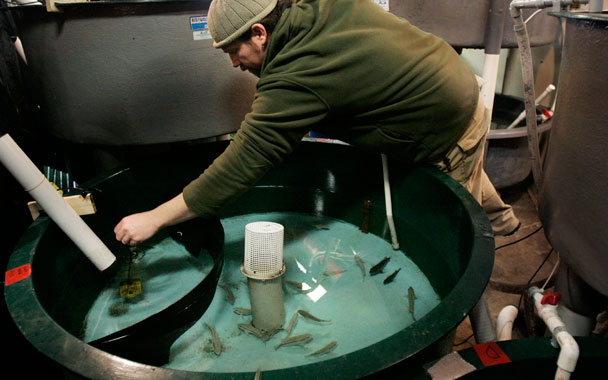You Can Lead a Bass to Water
But can you make it eat? In one of the most bizarre aquatic experiments I’ve heard of, researchers at the Marine Biological Station in Woods Hole, Mass., want to hold 5,000 juvenile black sea bass captive in a dome-shaped structure on the ocean floorsouth of Boston. They plan to broadcast a specific tone to the bass immediately before each feeding. After four weeks, the fish will be freed. The hope is that they will swim back to their enclosure every time they hear the tone, and that eventually such enclosures will be replaced by fishermen’s nets. In effect, schools of Pavlovian bass will swim to their own demise, prompting one reporter to wonder whether the next step would be teaching them to batter themselves.
The experiment, which was funded to the tune of $270,000 by the National Oceanic and Atmospheric Administration (NOAA), was opposed by the environmental group Food and Water Watch, which worried about the effects the trained fish would have on wild populations, but it received the final go ahead from the Army Corps of Engineers early this week.
Given all of the grave problems facing the oceans, you’d think that NOAA would have bigger fish to fry.
Beating a Very, Very Sick Horse
As part of our diet, trans fats are not quite dead—yet. But if you need one more reason to avoid consuming the heart-damaging substances, a recent study published in the journal Nutrition indicates that nursing mothers who consume partially hydrogenated vegetable oil might risk passing harmful effects to their babies. The researchers report that offspring of lactating rats that were fed trans fats suffered decreased heart function and insulin sensitivity.
Henhouse Update
I find it hard to summon sympathy for Tyson Foods, Inc., but no one can deny that it’s been a miserable week for the country’s second largest chicken processor. As noted in my last post, the company claimed that it was “voluntarily” (quotation marks emphasized) recalling packages of poultry labeled “antibiotic free” when, in fact, it had been ordered to do so by a court injunction.
To add insult to injury, The United States Department of Agriculture (USDA) said on Tuesday that Tyson not only used ionophores, which some consider to be antibiotics, in its feed, but also routinely treated chicks with gentamicin, unquestionably an antibiotic, and one also used on humans. The department ordered all “antibiotic-free” labels to be off Tyson chicken by June 18, a deadline that the company said was unrealistic.
But, I’ll hazard a guess, not as unrealistic as claims that the chicken beneath that label is antibiotic free.
And as if That Weren’t Enough . . .
This week Tyson announced that it had to gas to death and bury 15,000 hens from one of its Arkansas flocks that tested positive for exposure to a strain of bird flu.
The good news is that the USDA says the bug poses no danger to humans. The bad news is that Russia and Japan, in order to protect their own flocks from the disease, immediately imposed bans on the importation of chicken from Arkansas—a tough blow to an industry already struggling with soaring prices of the corn and soybeans it feeds its birds.




 Pinterest
Pinterest


